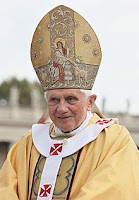 |
| Giotto - Adoration of the Magi |
Chapter 2 of St. Matthew’s Gospel begins with
these words:
After Jesus was born
in Bethlehem in Judea, during the time of King Herod, Magi from
the east came to Jerusalem and asked, “Where is the one who has been born
king of the Jews? We saw his star when it rose and have come to
worship him.”
First, a few considerations about this text:
- Magi is a term with different
meanings. Strictly speaking, it was applied to the priests of Mazdayasna,
the religion of Zoroaster. Zoroastrian magi were frequently devoted to
astrology (the name then given to the science we now call astronomy). So,
in a broad sense, the word magi could be applied to anyone
who worked in that science. The New Testament does not say that they were
kings. That is a later tradition.
- It will be noted that the text
does not say that they were three. They must be at least two, since the
term is plural, but later thinkers have discussed whether they were two,
three, or even six. The three magi is also a later
tradition.
- It is explicitly stated that
King Herod was alive. When did Herod die? Since Emil Schürer (1896) it has
been assumed that he died in the year 750 ab
Urbe condita (a.U.c., since the founding of Rome), which
corresponds to year 4 b.C.e. (before the Christian era). From this, many
historians deduced that Jesus Christ must have been born before that date.
Therefore Dionysius Exiguus, author of the idea of numbering the years since
the birth of Christ, would have made a mistake in assigning the year 754
a.U.c. to his birth. But some modern historians think that Herod could
have died in the year 753 a.U.c. (year 1 b.C.e.), and that his sons pushed
back the beginning of their own reign, thus causing the discrepancy and
leading Emil Schürer to a wrong conclusion. Consequently, the most
probable date for the birth of Christ would be between the year 7 b.C.e.
and the year 2 b.C.e.
The nature of the star that led the magicians
to Bethlehem has also led to countless lucubration, more or less credible. The
most widespread theories can be classified into several groups:
 |
| Pope Benedict XVI |
- It was a comet. Halley's Comet passed close
to the Earth in the year 12 b.C.e., so it should be eliminated. Chinese
and Korean astronomers signaled the possible passage of a comet on
February 23, 4 b.C.e. Against this theory is the fact that, first, the
passage of a comet used to be considered a bad omen, and second, according
to Aristotle, comets were meteorological phenomena, so the name star
would not be applied to them.
- It was a supernova. This theory was in vogue in
the mid-twentieth century, as evidenced by Arthur Clarke’s science fiction
short story (The Star, 1955) about a priest who loses his faith when he
discovers the remains of a planet inhabited by intelligent beings that was
destroyed by the explosion of its star, which when transformed into a
supernova became the star of Bethlehem. At that time it was thought that
the object indicated by the Chinese and Korean astronomers on February 23
of the year 4 b.C.e. may not have been a comet after all, but a supernova.
Later the theory of the supernova lost strength, although it was
resurrected in 1978 (The Christmas Star as a
Supernova in Aquila). In 2005 Frank Tipler proposed that it could have been a supernova in the Andromeda galaxy.
- It was a planetary
conjunction.
This is the most widespread theory. Several candidates have been proposed:
a conjunction of Jupiter
and Saturn in the Pisces constellation, which took place in the year 7
b.C.e. (Jupiter is the king planet; Saturn, for the Jews, represented the
Messiah; Pisces seems to have been the constellation of Palestine). Or the
conjunction of Jupiter with the star Regulus (the brightest of the
constellation of Leo, representing Judah) in September of the year 3 b.C.e.,
followed nine months later by a conjunction of Jupiter with Venus (the
mother). Since these two planets are the two brightest stars in the sky
(except for the sun and the moon), a conjunction in which they approach
until they become indistinguishable would give rise to the brightest star
ever seen. There has also been talk of a double concealment of Jupiter behind
the moon in Aries in March and April of the year 6 b.C.e.
- In his book Jesus of Nazareth: The Infancy Narratives,
third part of his trilogy about Jesus of Nazareth, Pope Benedict XVI
points out that some exegetes believe that theology should not be mixed
with astronomy. And he adds that St. John
Chrysostom had developed a similar position in the ancient Church.
In any case, the Pope recognizes that it would be
a mistake to reject a priori this question (whether the
star could have been a real astronomical phenomenon) because
of the theological nature of the narration.
- Of course, many atheist
historians solve the problem by denying that the text of the Gospel has
anything to do with real life and considering it as just fiction.
The problem of the star of Bethlehem, like that
of dating
the birth of Christ, is far from solved, but it is interesting that it is
still being addressed, not just by theologians and historians, but also by serious
scientists, especially astronomers, and that articles on the subject have been published
in important magazines such as
Nature.
The same post in Spanish
Thematic Thread on Science, Faith and Atheism: Previous Next
Manuel Alfonseca
No comments:
Post a Comment